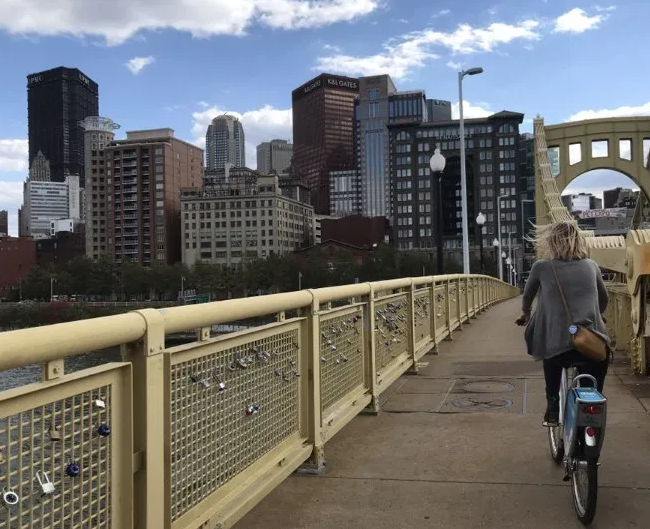I have been writing this goodbye in my head for a while now.
When I took this job at Streetsblog nine years ago, it seemed like a risky decision. I could have tried to stay at the government planning organization where I was working — in a basement — until I retired on a pension.
But working at Streetsblog seemed like a lot more fun. Prior to that, I had always been interested in cities and always been a cyclist and a transit supporter. But I had never been exposed to the ideology people had just started calling "urbanism," that tied it in with strong ideas about parking and zoning and land use.
Right away, though, it "clicked" for me. I thought it was exciting and progressive. It was great to find something that felt like such a good fit.
At the beginning, I mostly learned from our readers and my editor. Originally my job was partly helping "syndicate" Streetsblog Network blogs. There were as many as 400 of them from all over the country and world. And so I was reading the thoughts of all these local activists like Bill Lindeke in St. Paul and Kristen Jeffers in South Carolina (at the time) and Michael Andersen in Portland. We would sometimes debate things, but mostly we agreed we could have a healthier, more equal, more sustainable society if we reduced our dependence on driving.
I felt a lot of camaraderie and admiration — still do — for these mostly younger city dwellers, who were trying to improve their cities, like I was.
To my surprise, working at Streetsblog ended up being pretty stable. In the nine years I have been doing this, so much has changed. When I got started no one had dreamed of e-scooters. Barack Obama had just proposed high-speed rail as part of the stimulus bill. It was an optimistic time for the field.
Over the time I've worked here, I've seen projects planned, voted on and brought to fruition.
I got married and had two kids. And that changed the way I traveled. It turned me from more of a cycling advocate to more of a pedestrian advocate — an area I thought was under-explored and under-resourced.
Lately, just in the last few years I even finally got interested in cars (*cough cough* SUVs) and how they were impacting our issues. I believe I was the first one in the field to point out that SUVs may be responsible for the increasing number of pedestrian and cycling deaths. We reported that about a year before the Insurance Institute for Highway Safety and the Detroit Free Press confirmed it.
We also reported on the Koch Brothers' network shady efforts to undermine public transit before it was well known. It was later covered by the New York Times.
At some point, I decided instead of wasting my evenings on Facebook and Twitter, I should try to take a lot of the stuff I'd learned in all my reporting at Streetsblog and dive deeper into one topic. This spring, I signed a deal to write a book about the pedestrian safety crisis in America with Island Press. It will be published next fall.
Sometimes I try to take stock of where we are as a movement. In some ways, I feel disappointed. Biking growth has leveled off nationally. Uber and Lyft have added all these additional cars to the roads. Cities in the sun belt, many of them, still resist safety improvements even as they lose hundreds of residents a year and the threat of climate change becomes more and more urgent.
But in some ways, it's amazing how far we've come as well. These ideas have become much more mainstream. We're starting to see mandatory parking minimums disappear. More and more cities like Indianapolis and Tampa and Raleigh, and Atlanta and (fingers crossed) Detroit are voting to raise taxes to build a more transit friendly city. Paired with some of the vehicle automation stuff happening, I think we could see a city — maybe Seattle or Minneapolis or San Francisco — actually achieve zero deaths within a decade or two perhaps.
I'm rambling. But what I'm trying to say is, I love you guys. The readers who are so selflessly trying to make a contribution where they live. Everyone who challenged me and taught me something or called me out when I was wrong or missing something important. Everyone who got drinks with me when I came into their town or vice versa. That was so fun and cool for me.
Thank you to Streetsblog Publisher Mark Gorton and to my editors, Ben Fried (former) and Gersh Kuntzman (current), plus everyone I worked with. There are too many to name, Tanya Snyder, Noah Kazis, David Meyer, Clarence Eckerson Jr., Aaron Naparstek. I was really so lucky to have the opportunity to do such a fun and unusual job. In hindsight, I wasn't always right, but tried to do my best.
I don't know what I'm going to do next. But I have some ideas and a few things cooking. I'd like to try to help cities (and, really more important, suburbs) implement some of basic changes to save pedestrians' lives: things like bus shelters, streetlights and leading pedestrian intervals, especially in neighborhoods that haven't been well served.
Because I really believe in what we were trying to do here.
If you want to stay in touch follow me on Twitter @schmangee or you can email me personally by clicking here (I'll send you an email when the book comes up for pre-order if you'd like). I'll be doing some speaking this fall in Portland, Seattle and Detroit as well.
Thanks again! Keep fighting the good fight.






